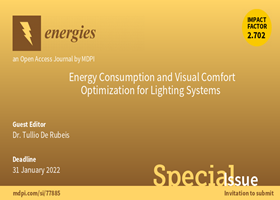Energy Consumption and Visual Comfort Optimization for Lighting Systems
A special issue of Energies (ISSN 1996-1073). This special issue belongs to the section "G: Energy and Buildings".
Deadline for manuscript submissions: closed (10 August 2022) | Viewed by 12016

Special Issue Editor
Interests: building physics; energy efficiency; lighting systems; dynamic simulations; lighting control systems; heat transfer; renewable energy
Special Issues, Collections and Topics in MDPI journals
Special Issue Information
Dear Colleagues,
In recent years, the need to reduce energy consumption together with the maximization of visual comfort has led to considerable advances in lighting systems performance. However, the energy consumption of lighting systems still accounts for around 20% of overall electricity consumption. Therefore, further efforts are needed to improve the energy performance of lighting systems, ensuring the highest visual comfort sensation.
This Special Issue on "Sustainable Buildings and Energy Performance" will collect scientific articles dealing with innovative research for lighting systems, taking into account different levels of knowledge. This Special Issue welcomes high-quality papers on the following topics:
- Daylight harvesting;
- Discomfort glare;
- Glazing system;
- Lighting control systems;
- Lighting experimental campaigns;
- Lighting simulations;
- Smart solutions;
- Visual comfort.
Dr. Tullio De Rubeis
Guest Editor
Manuscript Submission Information
Manuscripts should be submitted online at www.mdpi.com by registering and logging in to this website. Once you are registered, click here to go to the submission form. Manuscripts can be submitted until the deadline. All submissions that pass pre-check are peer-reviewed. Accepted papers will be published continuously in the journal (as soon as accepted) and will be listed together on the special issue website. Research articles, review articles as well as short communications are invited. For planned papers, a title and short abstract (about 100 words) can be sent to the Editorial Office for announcement on this website.
Submitted manuscripts should not have been published previously, nor be under consideration for publication elsewhere (except conference proceedings papers). All manuscripts are thoroughly refereed through a single-blind peer-review process. A guide for authors and other relevant information for submission of manuscripts is available on the Instructions for Authors page. Energies is an international peer-reviewed open access semimonthly journal published by MDPI.
Please visit the Instructions for Authors page before submitting a manuscript. The Article Processing Charge (APC) for publication in this open access journal is 2600 CHF (Swiss Francs). Submitted papers should be well formatted and use good English. Authors may use MDPI's English editing service prior to publication or during author revisions.
Keywords
- Case study
- Daylight
- Energy performance
- Energy efficiency
- Experimental campaign
- Lighting system
- Lighting simulation
- Visual comfort





